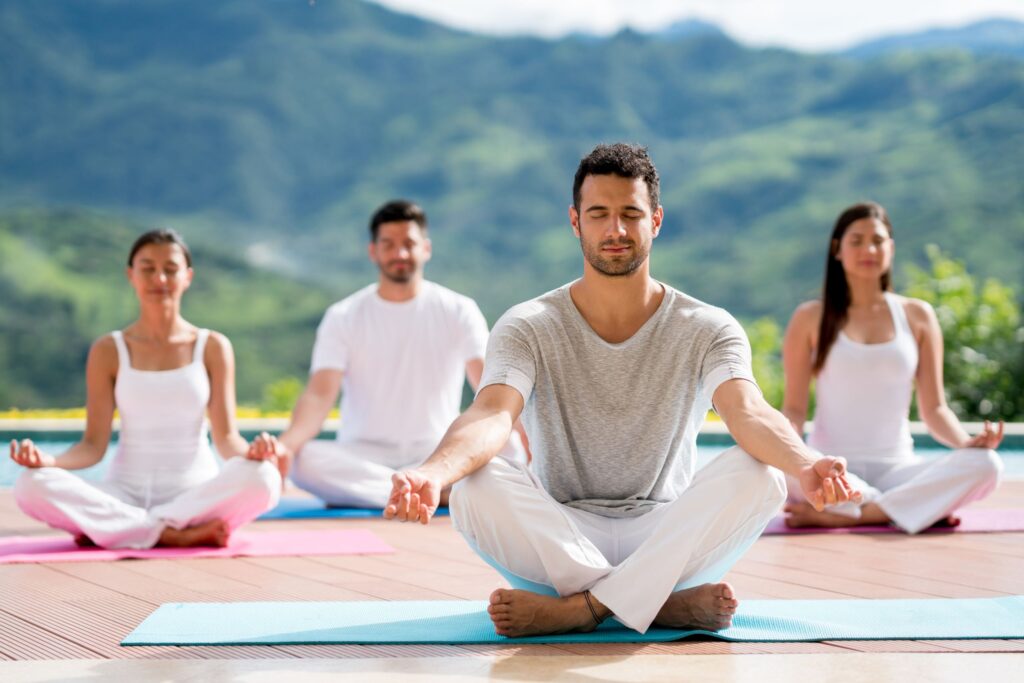Yoga Sequencing is the order and structure of a yoga class. It can be planned in terms of various themes or functions and should aim to provide space for students to explore movement connected to breathing safely. In this article, you will learn how to sequence a yoga class.
There are many different ways to plan a yoga class. Depending on the intention of the class and the audience it is being offered to, the possibilities are endless.
Yoga class sequences come in different shapes and sizes. Every contemporary school, such as Iyengar, Ashtanga, and Vinyasa, has its ideas about how to sequence a practice.
Most sequences are linear, that is one posture follows another in a logical step-by-step direction, moving from less challenging to more challenging and back to less challenging.
Generally, a sequence opens with simple warm-ups that set a theme for the practice, intensify to more challenging postures, slow to cooling postures, and end with relaxation.
Table of Contents
ToggleHow To Sequence A Yoga Class
The principles of yoga sequencing entail providing a student with a comprehensive practice of paying attention to breathing and the flow of postures.
If you want to know the answer to how to sequence a yoga class then you must keep these factors in mind.
Set An Intention
One may start the class with a distinct theme or intention in mind. This might be a particular emphasis, such as strength, flexibility, or balance, a peak pose, or it could be a philosophical idea like, self-compassion, mindfulness, or gratitude.
The intention directs the selection of postures and sequences as well as the overall mood of the class.
Yoga Class Setting
The goal of the session must fit the current season or appropriate time. For instance, themes or yoga sequences may be different in winter and summer, or day and night.
For instance, does this session aim to calm or energize the students? If the goal is to feel energetic then the sequence will incorporate rapid movements and if the goal is to promote relaxation then the session will incorporate calming postures.
The teacher may also share personal anecdotes or observations on the subject. This strengthens the bond between students and teachers and increases the theme’s relatability.
Assess Experience Level
More experienced practitioners benefit from more subtle hints and difficult sequences, while beginner pupils might need more thorough explanations and fundamental postures.
It is essential to take into account the student’s experience level, requirements, or the group’s general energy. This can help to prevent injuries by adjusting the lesson to their level and providing them with useful direction and instruction.
By adjusting the course to accommodate varying skill levels, the class promotes inclusion and a productive learning environment.
Time Management
Ensure that there is enough time allotted for each part of the sequence. Reflect on the posture categories. Make sure to give your class enough time for every type of pose.
One may choose to repeat all the poses twice or even replay short sequences. Spending enough time warming up and cooling down is important.
For instance, in a 60-minute class, the warm-up and warming poses would take around 20 to 25 minutes, followed by positions like hip openers and back bends, a cool-down with twists and forward bends that would take about 10 minutes, and savasana that would last for 12 to 15 minutes.
Balancing Elements
One would always want to leave the class feeling balanced, in addition to the precise objective you set for them. To do this, one may incorporate Incorporate a range of postures that focus on different body areas to create a balanced session.
For example, switch up by going back and forth between sitting, standing, and prone positions, strength-based and flexibility-boosting postures.
Incorporating pranayama or breathing techniques may be most effective at the start of the session to help one connect with their breath and be present.
Warm-Up
The body’s temperature is progressively raised during a warm-up to prepare the muscles, and joints, for more strenuous exercise.
This improves flexibility and reduces the risk of injury. Warming up also promotes better blood flow throughout the body.
Progressive Sequencing
Arrange the positions sequentially and work your way up to challenging positions. To construct a smooth sequence pay attention to the flow and posture transitions.
Strength is built gradually and muscle engagement is increased. This ensures the energy of the class is balanced uniformly throughout the practice.
Cool Down and Relaxation
Following a high-intensity yoga session cooling down enables the body to progressively revert to its natural state.
At the end of the session incorporate slow relaxing sequences of stretches and postures that will help to calm down. One may end the session with Savasana (corpse pose) to unwind and benefit from the postures.
A few minutes of guided imagery or meditation also helps to relax after the practice.
Also read: Yoga Cues for Teachers
How to Sequence A Hatha Yoga Class

After you have a plan on how to sequence your yoga class start planning the sequence of asanas and practice it on your own or teach it to your classes to deepen your understanding and improve your teaching abilities.
Here are some examples for you to start with.
1. Opening Mantra
The mind wanders a lot. Mantra chanting before starting our practice may help to focus our thoughts, bring us back to the present, and align with the purpose of the practice. It helps us to ground and center our energy for practice.
2. Warm-Up Sequence
Joints and muscles that are cold are more prone to injury and damage. One can reduce the chances of muscle pulls and strains by warming up the body and progressively increasing the heart rate.
It also helps you to mentally prepare for the session and establish a connection with the breath.
- Tadasana (Mountain Pose/ Palm Tree Pose)
- Tadasana Deltoid Stretch
- Standing Shoulder Rolls
- Neck Rotation
- Standing Side Bend
- Standing Side Stretch (Kati Chakrasana)
- Sun Salutation
3. Sun Salutation Sequence (Surya Namaskarara)
Starting your yoga practice with Surya Namaskar stretches and strengthens the entire body and prepares the body for advanced postures and practice. It increases circulation, boosts energy, and gets the body and mind ready for the day.
The Sun Salutation has twelve positions in its traditional form. However various varieties differ in terms of complexity and the type of yoga being practiced.
- Prayer Pose (Pranamasana)
- Raised Arms Pose (Hasta Uttanasana)
- Hand-to-Foot Pose (Pada Hastasana)
- Equestrian Pose (Ashwa Sachalasana)
- High Plank (Phalakasana)
- Eight-Limbed Pose (Ashtanga Namaskara)
- Cobra Pose (Bhujangasana)
- Downward Facing Dog Pose (Adho Mukh Shvanasana)
- Equestrian Pose (Ashwa Sachalasana)
- Hand-to-Foot Pose (Pada Hastasana)
- Raised Arms Pose (Hasta Uttanasana)
- Prayer Pose (Pranamasana)
Hatha yoga sequences its poses strategically. These poses maintain a consistent intensity level, are comparable in complexity, and flow well into one another. One of the aims of Hatha yoga is to smoothly transition into one asana after another.
It’s crucial to emphasize that you should do this gradually; that is, you can lower yourself into each posture until your last one is entirely on the ground.
As you teach, you may enlighten your students about the advantages of Hatha yoga for every level of asana.
Standing Poses – One may start with a warrior pose, reverse warrior, triangle pose, and tadasana. Next move on to Balancing postures.
Balancing Pose– Eagle pose, dancer pose, tree pose, fold forward, and come to downward dog to prime positions.
Prone Pose– Pigeon pose, locust pose, cobra pose, bow pose. Perform the rabbit pose or child pose to come to seated postures
Seated Pose– Perform seated postures like seated forward fold, boat pose, and seated twists.
Supine Pose – Recline back for supine postures like plow pose, knee to chest, bridge pose, and fish pose.
4. Savasana
Savasana, when performed at the end of asana practice, helps to soothe the central nervous system. The parasympathetic nerve system is activated during this time.
It restores the body to a state of deep relaxation and maintains equilibrium. We might lose out on the delight of post-yoga happiness when savasana is skipped.
5. Pranayama
The best way to blend pranayama with yoga poses will depend on the goals and personal taste. But pranayama is traditionally done after doing yoga poses.
The rationale behind this sequence is that completing asanas first aids in the body’s preparation for pranayama. Yoga poses open up the body, increasing its receptivity to prana, or the flow of energy.
Nevertheless, there is no hard and fast rule. Some practitioners prefer to perform pranayama first since they feel it helps focus the mind and establish a purpose for the practice.
Try out the strategies, and determine which one works best for you.
6. Meditation
Following Savasana one may also perform a mini meditation to end the practice. One of the most profound forms of meditation that is performed in the savasana is yoga nidra.
Yoga Nidra takes us to a level of consciousness that lies between awake and sleep when we discover that we are much more than our physical bodies.
To reach samadhi, the last level of yoga one must achieve complete union and experience deep stillness in body and mind.
7. Closing Mantra
The closing mantra chant serves as a means of ending the exercise with a wish for global peace and harmony as well as a sense of gratitude. It lets you walk off the yoga mat feeling serene and at peace with yourself.

